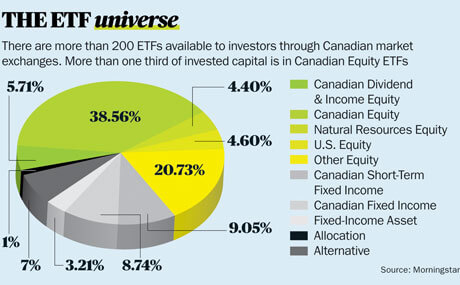How to use ETFs
Three strategies to help you get more out of your exchange-traded funds
Advertisement
Three strategies to help you get more out of your exchange-traded funds

Investors around the globe currently have more than $1 trillion invested in exchange-traded funds, thanks to their low fees, instant diversification and versatility. In Part I of this series we wrote about what ETFs are and how they work, and in Part II we wrote about how they trade on the exchanges. Now it’s time to address perhaps an even more important topic: How do you use ETFs?
It’s important to understand that ETFs are an investment product. They are not a strategy in and of themselves. As with stocks and mutual funds, depending on how you use them, they can be low risk or high risk. You can use them for short-term gambles, or to build a conservative nest egg that will last you a lifetime. It all depends on your investing style, your goals and your personality. Read on and we’ll walk you through three investing strategies, including the benefits and risks involved in each. We’ll also help you use ETFs to build a portfolio that suits your own unique needs and objectives.
Strategic asset allocation
The majority of individual ETF investors use a passive investment strategy known as strategic asset allocation. This involves selecting a consistent mix of stocks and bonds suited to your goals and risk tolerance. The investor then uses index ETFs to build his or her portfolio accordingly. The key is that the target allocation stays the same regardless of market conditions. So if you decide that your ideal portfolio consists of 60% stocks and 40% bonds, you would keep rebalancing your portfolio back to that original split, no matter what the market does.
The underlying belief is that it’s extremely difficult to beat the market on a long-term basis by trying to forecast which market sectors will perform best. Passive ETF strategies like this are suitable for investors looking to take advantage of lower costs and greater tax efficiency, as well as those who believe that tinkering with a portfolio based on market trends can do more harm than good.
Critics counter that this strategy is problematic because it can only achieve market averages, with no opportunity for superior returns. “And the critics are correct,” says Richard Ferri, author of The ETF Book and The Power of Passive Investing. “Passive portfolios will never beat the markets.” But Ferri quickly points out that the vast majority of active strategies tend to underperform the markets too — often by significantly more.
If you’re a low-maintenance, buy-and-hold investor who wants a portfolio of well-diversified holdings designed to capture market returns while keeping costs to a minimum, and you have little desire to tinker, then a strategic asset allocation strategy using ETFs may be perfect for you.
A key benefit is that passive investing is remarkably straightforward. “Long-term investors should start with a plain-vanilla portfolio using a passive approach,” suggests Preet Bannerjee, a financial writer and former financial adviser. For instance, you might invest in just four ETFs: one that follows the Canadian bond market, one that follows Canadian stocks, one that follows American stocks, and one that follows stock markets in developed countries around the world.

Tactical asset allocation
But what if you’re the type of person who religiously reads the business section looking for investment opportunities? If that describes you, then a tactical asset allocation approach may be a good fit. As with strategic asset allocation, you start with an asset mix that makes sense for your investment goals and time horizon. But with this strategy, you can actively pursue market sectors or asset classes that you believe will provide superior returns to the overall market when you see opportunities.
For example, if you think the price of gold will rise, you could temporarily overweight an ETF that follows the price of gold. If you think Brazil’s economy is about to take off, you could invest in an ETF that follows the market in Brazil. You could also actively overweight or underweight bonds, or real estate, or the pharmaceutical sector. Some ETFs even allow you to short the market so you profit if it drops.
While active strategies using ETFs and stocks are similar, there is one major difference: the instant diversification inherent with ETFs. When you invest in an oil ETF, for example, you can invest in the overall oil market, rather than a particular oil company.
Proponents of active strategies believe the biggest benefit to this strategy is that there is at least the potential ability to outperform the broad market indexes. Mark Yamada, president and CEO of PR Investing, a firm that specializes in constructing ETF portfolios, agrees, adding that tweaking a portfolio’s asset mix can also help to mitigate potential losses. “For instance, it would have saved your bacon in 2008 and early 2009,” he says.
Still, investors should remember that active investing is always more expensive. It requires much more research, and you may have to pay for advice. You’ll also incur higher transaction costs. Even if you pursue tactical asset allocation as a do-it-yourselfer, you’ll pay more in commissions and trading costs because of the higher turnover in your portfolio. The higher turnover could also mean paying more in taxes, which eats into your returns.
What to look for when buying an ETF
Core and explore
If the thought of always trying to time the market is overwhelming, but the idea of passively waiting for the markets to provide a decent return also leaves you frustrated, there is another option: the “core and explore” strategy. This involves investing the bulk of your portfolio (the “core”) using a strategic asset allocation strategy, while pursuing a more active approach with the “explore” portion, which might account for 10% or 20% or your holdings.
One variation of this strategy involves holding broad-market ETFs in the core portion of the portfolio and exploring with niche ETFs that follow specific market sectors, commodities or currencies. For example, you might use your “explore” holdings to make a concentrated bet on one or more of the major market sectors — consumer discretionary, consumer staples, energy, financials, health care, industrials, materials, technology, telecommunications and utilities — depending on market conditions. Let’s say you want to take a strong position in the biotech industry. Rather than hand-picking a couple of stocks, you could invest in an ETF that tracks the whole biotech sector — a major advantage considering that 50% of the companies in this industry fail.
Another technique is to build a core that uses passive ETFs in asset classes you believe are highly efficient, such as government bonds and large-cap stocks. Then you use a more active approach to overweight asset classes where you think there’s a greater chance of market-beating returns, such as emerging markets or small-cap stocks.
The largest benefit of the core and explore approach is that you get the market-tested benefits of a core passive portfolio along with the potential to add higher returns. But to pursue these superior returns you will have to pay more in trading costs. This means you’ll have to achieve better than market returns just to break even. “Explore strategies have to make up their higher expenses before delivering a benefit to your portfolio,” says Ferri.
Because of that, introducing an “explore” component only makes sense if your portfolio is large enough, explains Yamada. “If you have a $100,000 portfolio it doesn’t make sense, as the transactional costs alone will negate any gain in your returns.” He suggests implementing a core and explore approach when your portfolio reaches $300,000 or higher. As your portfolio grows then you can continue to look for additional active investment opportunities.
The perfect core
Whether you choose strategic asset allocation or core and explore, you’ll want to know how to create a solid passive portfolio. The first step is to determine what you want out of your investments. Then it’s a matter of constructing the portfolio to meet those particular goals. “Not taking this first step is like stepping on an airplane without a destination,” says Yamada. “You may be really keen to go on vacation but you have no idea where you’re going, you don’t know how to get there, and may actually run out of gas. The planning part is the most important part of portfolio construction.”
There are five basic strategic allocations you can use to start building your core portfolio, depending on your circumstances: income, conservative, moderate, moderate growth and aggressive. The mix between fixed income and equity will vary within each strategy — pick the one best suited to you.
For example, if you have built up a substantial portfolio and you’re getting close to retirement, then you need to take less risk, says Yamada. Choose a conservative or income allocation, with more fixed income and a smaller equity portion. If, however, the portfolio is meant to grow your wealth over the long term, or enhance your retired life, then take a bit more risk with the moderate, moderate growth or aggressive allocations, which are tilted toward equities. Once you know your objectives and your investing time line, you can then pick the ETFs that suit your needs. To get you started, visit our Couch Potato roadmap.
Share this article Share on Facebook Share on Twitter Share on Linkedin Share on Reddit Share on Email